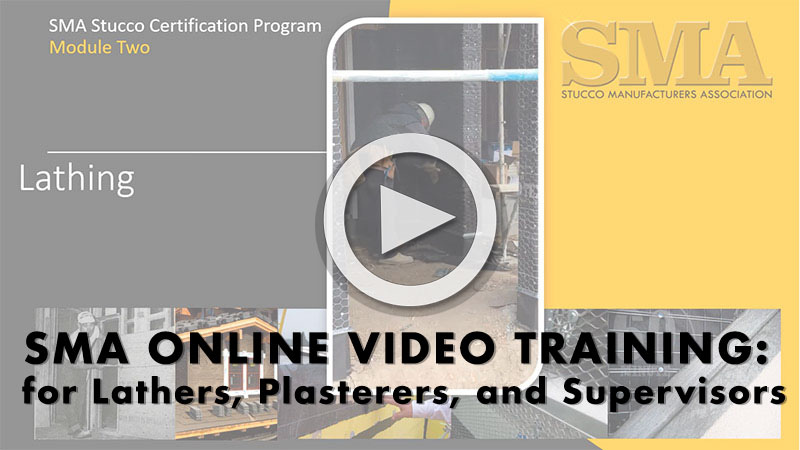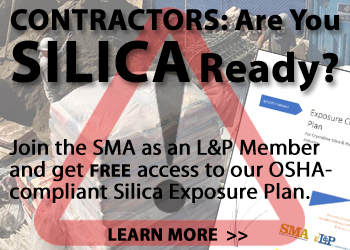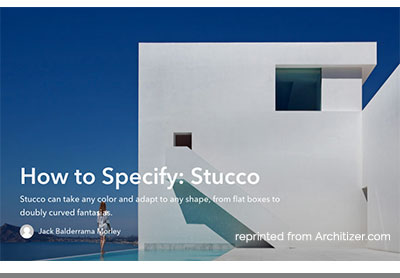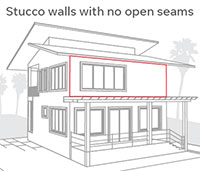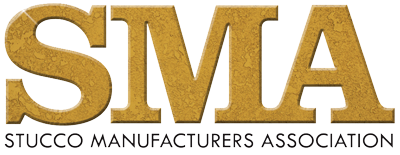PRESIDENT’S LETTER: Thinking Beyond Your Typical Competition

Kevin Wensel, Omega Products International
Plaster wall systems and stucco finishes remain a popular cladding option in many parts of the country, but there are some troubling trends. In some regions of the country that have been traditionally stucco, other claddings are starting to be used more often. Some of this change seems to be driven by the design trend to mix different types of claddings: designers like the look of combining plaster, stone, brick, and/or siding on one building.
Losing market share is something that our industry should be concerned about. I think we often look at our “competition” as other manufacturers that make the same products as our company — if you make stucco then other stucco manufacturers, if you make lath then other lath manufacturers, etc. We spend most of our energy trying to get the same projects that were already going to have plaster on them. This type of competition will always be part of business. However we also need to broaden our definition of competition to include other claddings.
As individual companies and as an industry, we need to try to increase the market share of plaster in areas where plaster and stucco could and should be more relevant. We need to be working with designers and builders to be explaining the benefits of plaster versus other claddings. We should also be working with applicators and local jurisdictions to insure the plaster is being applied properly, so that issues are mitigated and plaster has a good reputation.
In short, fighting over the same slice of pie is not the best use of our energy and collective talents, we should grow our collective market. Consumers like the stucco look, designers want to use stucco, so it is an open market. Our challenge is that some industries try to frighten consumers about stucco or plaster. Stucco is an amazing cladding and one of the lowest cost life cycle claddings over a 30-year period. With all the benefits of stucco cladding, our market should be expanding.
The SMA is uniquely positioned to help be an advocate for the industry. We are actively working on plans to promote stucco and help drive increased market share. If you have ideas and/or are willing to participate in this goal, then please contact Mark Fowler or me. Together we can keep the stucco market strong and growing.

FROM THE EXECUTIVE DIRECTOR: SMA’s Influence in the Industry

Mark Fowler, SMA Executive Director
When I started as Executive Director for the SMA, I had a decent idea of what to expect. What I was unaware of was the influence the SMA has in the industry. As the Director, I receive the reports on the number of hits and visits to your SMA website. For January we had a total 107,787 hits from 8,726 visits and a plethora of other information that seems staggering. The confirmation of these numbers is how many phone calls and emails keep pouring in. I became a believer — the numbers and the SMA are for real. Many calls come from outside of California. Michigan, Mississippi, New York, New Mexico, Florida, Washington, Utah and Texas have all been calling the SMA. Almost all are looking for answers to a technical question or some kind of help with plaster or stucco. The calls are from architects, builders, home owners and even building inspectors. Trying to answer all the calls and emails is a daunting task. But we see the SMA as the Better Business Bureau for the plaster industry, and we are here to help.
Stucco is great cladding, and done correctly with good product, there is no better cladding for your building. Conversely, if the wrong products are used or an improper installation of lath and/or plaster is done, stucco can seem to be the worst selection in cladding. Stucco can work in Alaska, Arizona or New York; it just has to be installed correctly. The mystery and variety of options in stucco application has designers and owners confused and this is the driving force behind the Lath and Plaster Committee of the SMA. The SMA is striving to provide standards and develop a quality assurance program to improve the stucco market. Successful stucco projects mean that others will follow; stucco failures result in a loss of trust in a cladding and will result in a shrinking stucco market. This is our future, and all of us must put our best foot forward to promote good practices and keep stucco growing. Feel free to contact the SMA with any suggestions, comments or concerns. We welcome everyone as we work together to grow your plaster market.
NEW TECH BULLETINS
The SMA committees are hard at work producing a series of specifications, details and bulletins to improve the stucco industry. The goal is to create the most extensive technical library for lath plaster in the industry that has the widest industry input. SMA and the Lath and Plaster Committee are made up of manufacturers, dealers, contractors, consultants and architects. SMA members wishing to be on a specific committee should contact the SMA office. There are currently four active committees:
- Three Coat Stucco
- One Coat Stucco
- Accessories
- The Lath and Plaster Committee
Each committee member has input on the various items being proposed for their specific committee. Once the committee approves the bulletin, it then moves to the SMA board of directors for final approval and publication. Members are expected to abide by the SMA bulletins.
THE LATH AND PLASTER COMMITTEE
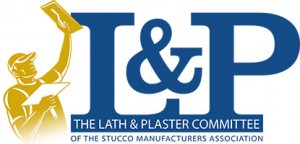 The Lath and Plaster committee is a part of the SMA. L&P committee members are contractors who install lath and plaster and desire to improve the industry and best practices. L&P members hold themselves to a higher standard and have agreed to follow SMA guidelines and By-Laws.
The Lath and Plaster committee is a part of the SMA. L&P committee members are contractors who install lath and plaster and desire to improve the industry and best practices. L&P members hold themselves to a higher standard and have agreed to follow SMA guidelines and By-Laws.
Plastering contractors interested in joining the SMA Lath and Plaster committee need to submit three references for approval into the SMA. Once approved, they must abide to the By-Laws to remain a member in good standing.
SMA STUCCO STUDY
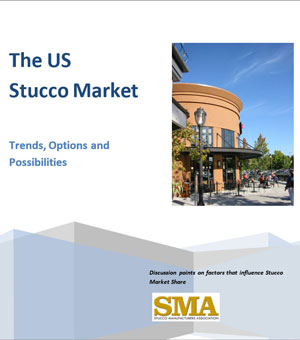 The SMA marketing committee has nearly completed its report titled “The U.S. Stucco Market.” This report will contain data from the U.S. census bureau on exterior claddings gathered since the 1970s. It covers historical trends on wood, brick, vinyl, stucco and fiber cement board with regard to market share. Data include predictions from the research team at the University of Kentucky on which claddings are likely to gain market share and which may become irrelevant. The report covers all regions of the U.S. and breaks down the market share numbers in each region.
The SMA marketing committee has nearly completed its report titled “The U.S. Stucco Market.” This report will contain data from the U.S. census bureau on exterior claddings gathered since the 1970s. It covers historical trends on wood, brick, vinyl, stucco and fiber cement board with regard to market share. Data include predictions from the research team at the University of Kentucky on which claddings are likely to gain market share and which may become irrelevant. The report covers all regions of the U.S. and breaks down the market share numbers in each region.
The report also includes information from various stucco experts with decades of experience in the stucco market. Areas of expertise include training, code development, leaks, litigation, union market share and productivity shifts for the stucco market.
Several factors are examined that influence building owners, architects and even the contractors on the decision to use stucco. The report explores the one-coat stucco market in comparison to the three-coat market. The report explores the regional influences that tend to impact how stucco is used and installed. Recent innovations or trends such as Continuous Insulation, Rain Screen, Crack suppression and air barriers will have an impact on the stucco products manufactured, sold and installed.
Stucco cladding is an option and in competition with other claddings. If you are involved with stucco, this report will assist you in being better prepared to make strategic decisions about the future. Most marketing experts agree understanding the past trends of success or failures, even with other claddings, can help you make more informed decisions. The report will be available to SMA members by late Spring 2016.
PLEASE NOTE: SMA OFFICE CONTACT INFORMATION
Mark Fowler, Executive Director
Marlene Lampert, Office Manager
Stucco Manufacturers Association
5753 E Santa Ana Cyn Rd, Suite G-156
Anaheim, CA 92807
Office: 213 379 5890
Mark@stuccomfgassoc.com
Marlene@stuccomfgassoc.com
SAVE THE DATE: MAY 11 LUNCH MEETING

The May 11 meeting of the SMA will feature guest speaker Michael Roberts of Construction Analysis Group II Inc. Mr. Roberts is experienced in plastering and the litigation surrounding lath and plaster, and he is well known as an industry expert. Mr. Roberts will explain the current trend in insurance coverages, including court decisions, that anyone selling, installing or even touching stucco or EIFS needs to know to protect themselves in the future.
Mark Fowler, SMA Executive Director, will present a brief overview of the SMA’s new report “The U.S. Stucco Market.” This in-depth report includes data from the U.S. Census Bureau and other sources, with trends and predictions for all regions of the United States specific to stucco. A copy of the new report will be available to each SMA member present at the meeting. If you manufacture, sell or install stucco/EIFS, you will not want to miss this meeting. Space will be limited; sign-ups will start April 15 on the SMA website.
WELCOME NEW MEMBERS
Tarlton and Son, Inc.
 Tarlton and Son Inc, from Fresno, has a long history of plastering in California. Their projects range from homes to large commercial work and with three offices they pretty much cover the state. For more information contact Shawn Curry or Blaine Steel at 559.486.0584.
Tarlton and Son Inc, from Fresno, has a long history of plastering in California. Their projects range from homes to large commercial work and with three offices they pretty much cover the state. For more information contact Shawn Curry or Blaine Steel at 559.486.0584.
Paoli and Company
Gary Paoli of Paoli and Company has been a designer, contractor and an expert witness. Gary graduated USC with a degree in Architecture and is available for consulting and expert witness work. Gary can be reached at 714.315.6463.
Edward Takahashi, FAIA
Mr. Takahashi is a registered architect and has been involved with some of the state’s major projects. He provides consulting services and expert witness work. Ed can be reached at 323.980.8000.
FEATURE ARTICLES
MARBLECRETE, A ROSE BY ANOTHER NAME
For those of us not in the Florida stucco market, we might take a lesson in innovation of stucco. Marblecrete is a cement stucco finish that was popular on the west coast starting in the 1950s and finally all but died out in the ’80s. The technical name was exposed aggregate, but most of us knew it as marblecrete. Most marblecrete was used on commercial work; big chain stores such as Sears or malls found marblecrete durable and attractive. Marblecrete is known as rock or slop dash in Canada. The city of Vancouver BC still sees new installations of this unique finish being done today. The end result is a very durable wall that has the ultimate crack hiding abilities. The finish had unique installation procedures.
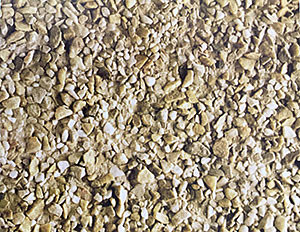
The Process:
The water resistant barrier(s) and lath are applied as normal. The cement scratch coat is applied and let to set or cure. The next step is when things change. The brown coat is now called a “bedding” coat. The bedding coat provides a base and matrix to bond and secure the exposed aggregate, generally about 1/8″ to 1/2″ in size, in place. In most cases the bedding coat is a white or light colored cement applied to a nominal 1/2″ thickness. Gray cement can be used or other pigments added to white cement. Bedding coats can be plain cement or have polymer admixtures. A pre-selected aggregate of color and size is then forced into the bedding coat. The aggregate can be thrown at the fresh bedding coat with a paddle, scoop or the use of a rock gun. The rock run is machine that will shoot the aggregate with sufficient force to embed the aggregate into the bedding coat.
The aggregate has traditionally been marble chips or small pebbles. The marble chips are the same chips used in decorative precast concrete and terrazzo flooring. Most are number 0 to 3 size chips and still available today in a wide range of colors. Some projects used control joints or reveals to create unique patterns and add more uniqueness by altering the colors of the chips selected.
The Florida Twist:
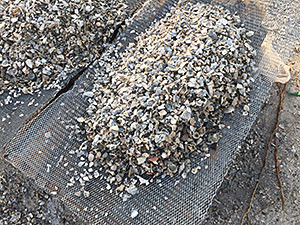
In Florida, sea shells are abundant and easy to get. They have been used as an aggregate in concrete and asphalt streets for many years. Apparently they can also be used in stucco walls. It is not marblecrete, but could be called shellcrete? The sea shells are first washed to remove all salts and contaminates and then screened to provide uniformity in sizing. Then they are applied just as the more traditional marble chips. Some designers are might consider using glass aggregates to expand the variety in color and texture. Could recycled glass aggregates be potential LEED points?
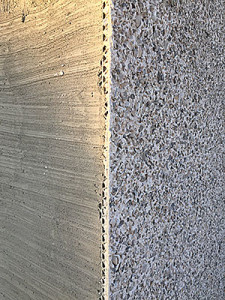
The application of the aggregate requires skill and force to insure they are sufficiently embedded into the cement. Even done correctly, much of the marble, glass or sea shell will fall to the ground. Experienced contractors will place tarps on the ground to catch the bulk of the fallen aggregate for re-use later.
Renovation of Marblecrete:
The SMA occasionally receives questions about renovation of the marblecrete. Can it be cleaned, plastered or painted are common questions. The answer is yes, yes and yes. Cleaning is best done with a mild detergent being sprayed on a pre-wetted wall and then washed off. Power washers are discouraged for cleaning marblecrete. High pressure can dislodge the exposed aggregate. After cleaning, a sealer made by an SMA manufacturer can then be applied to keep the marblecrete looking clean.
It is also possible to apply stucco finish over sound and solid marblecrete. The first step would be to clean any bond breaking material off the wall. A power washer could be used for this purpose. A skim coat of cement can be applied to level the wall out smooth. A test patch is always recommended to insure a good bond to the marblecrete. Refer to an SMA manufacturer about products best suited for skim coating. The trickiest issue is the termination of the plaster to trim accessories such as control joints or casing beads. Since the aggregate is generally proud of the finished edge, it takes a little time to feather or round the edge along the joints. Once the skim coat is complete, a traditional cement or an acrylic finish coat can be applied. It is important to insure the skim coat and finish coat are compatible.
Another option is to use fog coat over clean, unpainted marblecrete. Fog coat is a cement-based paint. Fog coat will make the marblecrete uniform in color, while avoiding blisters, bubbles and other common issues found when applying traditional paint over marblecrete. A test patch should be done to insure the aggregate will absorb the fog coat. This is the most economical fix.
It is recommended to use an SMA contractor familiar with fog coat procedures and approved SMA products.
ONE-COAT STUCCO
One-coat stucco was born in the 1970s during the first energy crisis. The use of one-coat versus three-coat today is primarily regional. Some areas strongly prefer three-coat while other markets predominantly are one-coat markets. Both products will work in all climates, though some believe that one-coat stucco is inferior because it is only “one-coat.” First, it should be noted that one-coat is really two coats. Three-coat is two coats of base material, one-coat is essentially the same but the basecoat is done in one coat. Hence the name “one-coat.” Both plaster systems still get a finish coat of material. Three-coat stucco has a slightly thicker base coat than one-coat. A one-coat stucco membrane is generally 3/8″ to 1/2″ in thickness, while a three coat is 3/4″ in nominal thickness. Both systems, when done correctly, serve as excellent claddings, and usage is generally dictated by preferences of historic usage. Problems arise when either system is short-cutted, cheapened or installed incorrectly.
The SMA supports both one- and three-coat stucco and urges best practices for each be followed. This means following the SMA product and installation guidelines established by the SMA, the Lath and Plaster Committee and manufacturers’ recommendations.
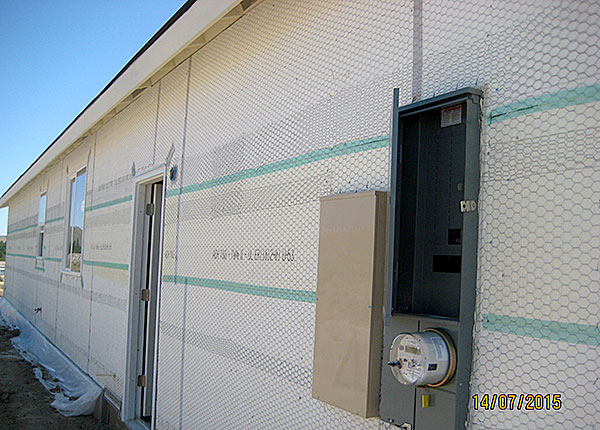
As noted, one-coat stucco was developed to be applied over rigid foam to provide energy savings. There are thousands of square yards of one-coat stucco over foam in California, Texas, Arizona and Nevada that have proven themselves for over thirty years of service. One-coat stucco has also proven itself in the more extreme climates of Utah and Colorado. One-coat stucco is similar to other claddings: installed correctly, it works fine, installed wrong, it can spell trouble. It is strongly recommended to use only SMA one-coat products that are installed by SMA Lath and Plaster committee contractors. All SMA one-coat stucco products are recognized and approved for “Continuous Insulation” applications to meet new energy codes.
There are a few limitations for the use of one coat stucco, so refer to your SMA manufacturer’s product report for limitations.
SPRING TIME EFFLORESCENCE

Spring is the time efflorescence starts to show up on projects. Most understand that efflorescence is a white salt/mineral deposit that exudes itself from cements. The problem is worse in Spring and even more noticeable on dark colored stucco. The one reason is the white bloom naturally stands out against the dark background. There is another reason the dark color is more likely to show efflorescence on a dark color.
As rain washes down the stucco exterior, the water is drawn into hairline cracks. The crack absorbs and holds the moisture. As the moisture sits in the crack, the mineral salts are absorbed into the water-laden stucco.
NOTE: the water that enters in the cement membrane is very minor. The hairline crack swells slightly and the chance of a water intrusion leak is extremely low. Past inspections have revealed the paper behind the stucco membrane barely gets wet, even after hours of continuous rain.
As the sun hits the dark wall, it heats up quickly and accelerates moisture drive to the outside. The salts are drawn out faster and, as the water evaporates quickly, the salts are deposited on the surface. It has been noted that dark colored walls tend to have more efflorescence issues than light colored walls.
PRESS RELEASES FROM OUR MEMBERS
HORN ANNOUNCES PROMOTIONS
 SMA member HORN is proud to share the promotion of Eva O’Keefe and Jay Umphrey to vice president. Eva currently serves as secretary on the board of Los Angeles Society of Coatings Technology (LASCT) and supports the nonprofit, You Be the Chemist. Jay is a long-time member of LASCT where he has served as chairman of multiple committees and is a proud member of the Stucco Manufacturers Association.
SMA member HORN is proud to share the promotion of Eva O’Keefe and Jay Umphrey to vice president. Eva currently serves as secretary on the board of Los Angeles Society of Coatings Technology (LASCT) and supports the nonprofit, You Be the Chemist. Jay is a long-time member of LASCT where he has served as chairman of multiple committees and is a proud member of the Stucco Manufacturers Association.

